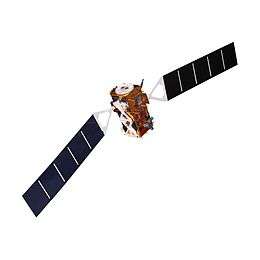Paz (satellite)
Paz (Spanish for "Peace") is a Spanish Earth observation and reconnaissance satellite launched on 22 February 2018. It is Spain's first spy satellite.[2] The satellite is operated by Hisdesat.[3] Paz was previously referred to as SEOSAR (Satélite Español de Observación SAR).[4]
 Paz undergoing integration at SpaceX prior to launch | |
| Names | SEOSAR |
|---|---|
| Mission type | Earth observation Reconnaissance Intelligence |
| Operator | Hisdesat |
| COSPAR ID | 2018-020A |
| SATCAT no. | 43215 |
| Mission duration | Planned: ≥7 years Elapsed: 2 years, 5 months, 25 days |
| Spacecraft properties | |
| Manufacturer | Airbus Defence and Space |
| Launch mass | 1,341 kg (2,956 lb) |
| Dry mass | 1,282 kg (2,826 lb) |
| Dimensions | Hexagonal: 2.4 × 5 m (7.9 × 16.4 ft) |
| Power | 850 W |
| Start of mission | |
| Launch date | 22 February 2018, 14:17 UTC |
| Rocket | Falcon 9 Flight 49 |
| Launch site | Vandenberg, SLC-4E |
| Contractor | SpaceX |
| Orbital parameters | |
| Reference system | Geocentric |
| Regime | Low Earth |
| Perigee altitude | 507.2 km (315.2 mi) |
| Apogee altitude | 509.5 km (316.6 mi) |
| Inclination | 97.45° |
| Period | 94.79 minutes |
| Epoch | 20 September 2018, 07:51:55 UTC[1] |
| Transponders | |
| Band | X band |
| Bandwidth | 300 Mbits/sec |
Overview
For observational purposes, Paz uses a synthetic aperture radar (SAR) to collect images of Earth for governmental and commercial use, as well as other ship tracking and weather sensors, which enables high-resolution mapping of large geographical areas at day and night.[3][5] The X-band radar imaging payload operates at a wavelength of 3.1 centimetres (1.2 in), or a frequency of 9.65 gigahertz.
The Paz satellite is operated in a constellation with the German SAR fleet TerraSAR-X and TanDEM-X on the same orbit. The collaboration was agreed on by both Hisdesat and former European aerospace manufacturer Astrium, operator of the two other satellites.[4][6] The high-resolution images will be used for military operations, border control, intelligence, environmental monitoring, protection of natural resources, city, and infrastructure planning, and monitoring of natural catastrophes.
Originally, Paz was scheduled for launch from the Yasny launch base, Russia, in 2014, but this was delayed due to Russia's 2014 annexation of Crimea, resulting in an International Court of Arbitration legal battle between Hisdesat and Kosmotras. The US launch was estimated to cost around €53 million, cost partially reduced by the inclusion of several mobile internet satellites on the same flight.[2]
Launch
The satellite launched on a reused Falcon 9 rocket by SpaceX from Vandenberg Air Force Base, SLC-4E on 22 February 2018 at 14:17 UTC. The satellite hosted two secondary payloads: an AIS receiver and the Radio-Occultation and Heavy Precipitation (ROHP) experiment.[7] The launch was shared by two 400 kg (880 lb) SpaceX test satellites for their Starlink, named Tintin A and B.[8][9] It was the final flight of a Block 3 first stage, and reused the booster B1038 from the Formosat-5 mission.[10] Paz weighs 1,282 kg (2,826 lb),[10] and its total mass with fuel is 1,341 kg (2,956 lb).[8] The payloads were carried to a Sun-synchronous dawn-dusk orbit.[3] The launch was originally scheduled for 30 January 2018.[5]
The booster flew without landing legs and was expended at sea.[8] It also featured Fairing 2.0 with a recovery attempt using a crew boat named Mr. Steven that is equipped with a net. The fairing narrowly missed the boat, leading to a soft water landing.[11][12]
Gallery
References
- "Paz - Orbit". Heavens-Above. 20 September 2018. Retrieved 21 September 2018.
- Ford, Matt (10 February 2018). "Elon Musk's SpaceX to launch Spain's first military spy satellite". EuroWeekly News. Archived from the original on 27 March 2018. Retrieved 6 April 2018.
- "Paz Earth Observation Satellite - Airforce Technology". Airforce Technology. Retrieved 7 February 2018.
- "PAZ". eoPortal. European Space Agency. Retrieved 7 February 2018.
- "Launch Schedule". Spaceflight Now. Retrieved 7 February 2018.
- "TerraSAR-X & PAZ Constellation : Airbus Defence and Space". www.intelligence-airbusds.com. Archived from the original on 9 March 2018. Retrieved 22 February 2018.
- "Hisdesat Commits Launch of PAZ Satellite to SpaceX" (Press release). Hisdesat. 7 March 2017. Archived from the original on 22 August 2017. Retrieved 22 August 2017.
- Atkinson, Ian (11 February 2018). "Falcon 9 static fires at Vandenberg ahead of Paz + Starlink launch". NASASpaceFlight.com. Retrieved 12 February 2018.
- Krebs, Gunter. "MicroSat 2a, 2b". Gunter's Space Page. Retrieved 17 January 2018.
- Krebs, Gunter. "Paz". Gunter's Space Page. Retrieved 9 March 2017.
- "SpaceX Falcon 9 set for PAZ launch with Starlink demo and new fairing". NASASpaceFlight.com.
- Musk, Elon. "Missed by a few hundred meters..." Twitter.com.
.jpg)
.jpg)
.jpg)
.jpg)

